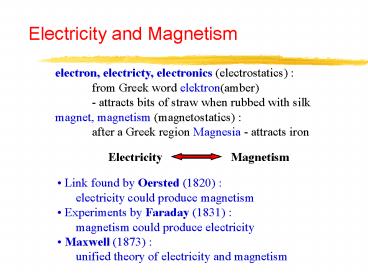Electricity and Magnetism PowerPoint PPT Presentation
1 / 14
Title: Electricity and Magnetism
1
Electricity and Magnetism
electron, electricty, electronics
(electrostatics) from Greek word
elektron(amber) - attracts bits of straw when
rubbed with silk magnet, magnetism
(magnetostatics) after a Greek region Magnesia
- attracts iron
Electricity
Magnetism
- Link found by Oersted (1820)
- electricity could produce magnetism
- Experiments by Faraday (1831)
- magnetism could produce electricity
- Maxwell (1873)
- unified theory of electricity and magnetism
2
Unity of Electricity Magnetism
Changing electric and magnetic fields are linked
- change in magnetic flux produces an electric
field - change in electric flux produces a magnetic field
- Similarity of Motors and Generators
- Motors use magnetic forces on currents
- Generators use electric fields induced by
rotating magnets - Light is an Electromagnetic wave
- Speed of light can be found from electrical and
magnetic measurements - EM is evident everywhere
- Macroscopic scale -- Lightning, main power
- Microscopic scale -- Atoms, nuclei
3
Maxwells Equations - Differential Form
- Gausss Law
- Gausss law for Magnetism
- Amperes Law
- Faradays law
where
and
4
Applications of Maxwells Equations
- Electromagnetic Wave Equation
- Charged Particle Equation of Motion
where
and
5
Electric Charge
- In nature () and (-) charges cancel each other
to an incredible degree. - Electrostatic effects are due to a slight
imbalance.
Electrostatics Study of charges at rest or
moving slowly with respect to each other.
Basic Rule Like charges repel and unlike charges
attract
Applications
- Xerox process
- fly ash precipitators (power plants, etc)
- home dust precipitators
- ink-jet printers
6
Quantization of Charge
Many elementary particles are made of quarks p
(uud) n (udd) e
Elementary charge
e 1. 602 X 10-19 C
7
Conservation of Charge
- Individual charges may be created or destroyed
- there is no change in the total net charge.
- Annihilation of particle and anti-particle
- e e- --gt ? ?
- Pair production
- ? --gt e e-
- Nuclear decay
- 238U --gt 234Th 4He
Does not happen !
8
Conductors and Insulators
- Good conductor
- electrons weakly attached to atoms, free to move
around in material (Cu or Al) - Insulator (poor conductor)
- electrons strongly bound to atoms, can distort
the atoms (polarize) but hard to free up the
electrons (glass, teflon) - Semiconductor (in between)
9
Charging up an object
- Direct contact / transfer
- demo - charged rubber/ glass rods
- transfer electrons between objects
- Charging by induction
- redistribute the electrons on a conductor using
an external charged object - use ground as a source of electrons
Charge density on an object Use this concept
when charges are so close together they look like
a continuous distribution of charge.. ? (C/m), ?
(C/m2), and ? (C/m3)
10
Coulombs Law
- Force between two charges
- Coulombs law
- k1/4??o8. 99x109 Nm2/C2
- ?o8. 85x10-12 C2/Nm2 permittivity constant of
free space - q - coulomb (abbreviation C), r - meters
- Fundamental law of electric force between two
charges q (not derived by observation) - Vector quantity !
- Inverse square law, like gravitational force
- Attraction/repulsion in sign of q1q2
- Strong force !
11
Gravitation and Electrostatics
Compare the gravitational and electric forces of
attraction between electron and proton in the
Hydrogen atom. Assume r 0. 53x10-10 m
me 9. 11x10-31 kg mp 1. 67x10-27 kg
qe -qp -1. 60x10-19 C G 6. 7x10-11 Nm2/kg2
12
Coulombs Law (Vector Form)
- is force on 1 duo to the presence of 2
- is vector from 2 (origin of force) to 1
Principle of Superposition
Vector sum
13
Principle of Superposition
Coulomb Force , acting on a charge q is
Coulomb Force for Charge Distributions
14
Shell Theorem for Electrostatics
- A uniform SPHERICAL shell behaves for external
points as if its charge is concentrated at the
center - A uniform SPHERICAL shell of charge exerts no
force on a charged particle placed inside the
shell. - These theorems allow problems to be simplified
tremendously. Radial charge density can vary !

